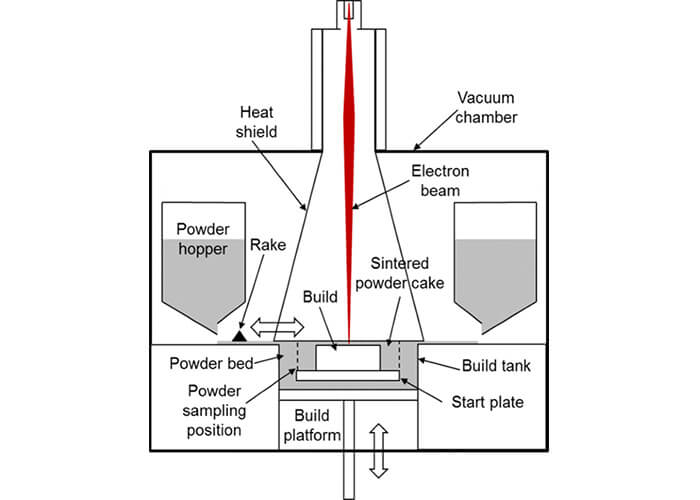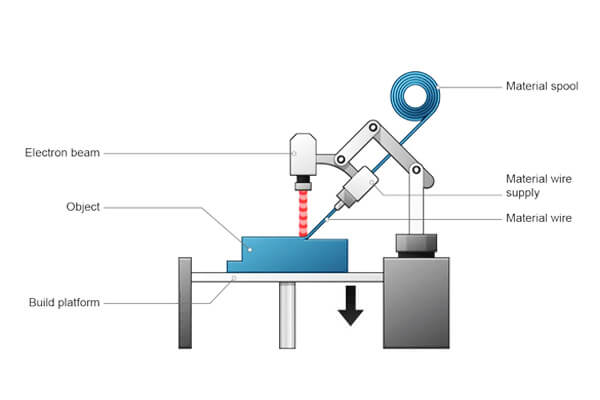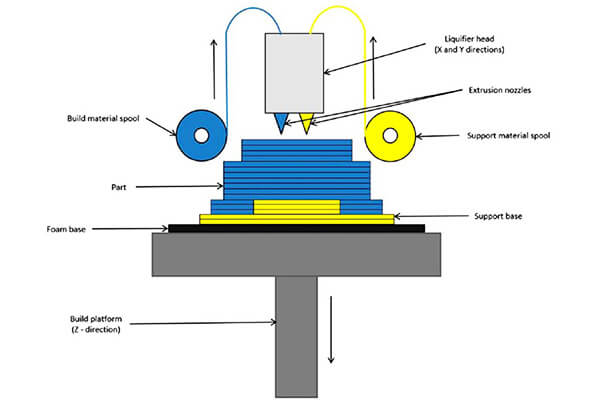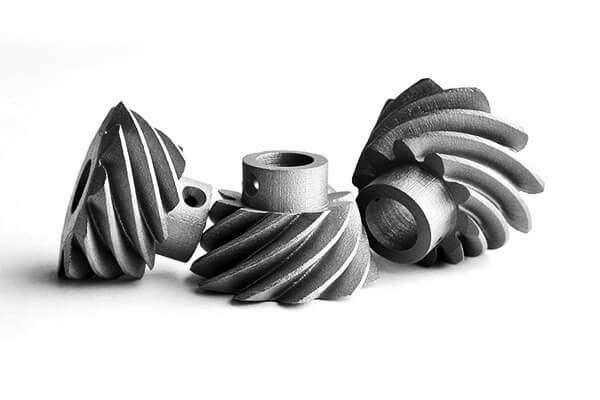1. Bekendstelling
Metaal 3D-drukwerk, ook bekend as metaal byvoeging vervaardiging, is 'n rewolusie in die manier waarop produkte ontwerp word, prototipe, en vervaardig.
Hierdie tegnologie maak voorsiening vir die skepping van komplekse, hoëprestasie-onderdele direk vanaf digitale modelle, bied ongekende ontwerpvryheid en materiaaldoeltreffendheid.
Hier is hoekom metaal 3D-drukwerk besig is om aan te trek:
- Aanpassing: Dit maak die vervaardiging van hoogs pasgemaakte onderdele vir nistoepassings moontlik.
- Vinnige prototipering: Versnel die ontwerp-iterasieproses aansienlik.
- Verminderde afval: Produseer onderdele met minimale materiaalafval in vergelyking met tradisionele vervaardiging.
- Komplekse meetkunde: Maak voorsiening vir die skepping van ingewikkelde vorms wat onmoontlik of baie duur is om met konvensionele metodes te vervaardig.
In hierdie blog, ons sal in die proses delf, voordele, uitdagings, en toepassings van metaal 3D-drukwerk, ondersoek hoe hierdie tegnologie die vervaardigingslandskap hervorm.
2. Wat is Metal 3D Printing?
Metaal 3D-drukwerk is 'n vorm van bykomende vervaardiging waar lae materiaal, tipies in die vorm van poeier of draad, word saamgesmelt om 'n driedimensionele voorwerp te skep.
Anders as tradisionele subtraktiewe vervaardiging, wat behels die wegsny van materiaal van 'n soliede blok, additiewe vervaardiging bou die voorwerp laag vir laag op.
Hierdie proses bied aansienlike voordele in terme van ontwerp buigsaamheid, materiaal doeltreffendheid, en produksiespoed.

Die geskiedenis van metaal 3D-drukwerk dateer terug na die 1980's, met die ontwikkeling van Selective Laser Sintering (SLS) en direkte metaallasersintering (DMLS).
Oor die jare, vooruitgang in lasertegnologie, materiaal, en sagteware het gelei tot die evolusie van verskeie metaal 3D-druktegnologieë, elk met sy eie stel vermoëns en toepassings.
3. Metaal 3D-druktegnologieë
Metaal 3D-drukwerk, Ook bekend as Toevoegingsvervaardiging, gebruik verskeie tegnieke om komplekse en funksionele metaalonderdele laag vir laag te vervaardig, direk vanaf 'n digitale lêer.
Elke metaal 3D-druktegnologie het sy unieke proses en voordele, wat dit geskik maak vir verskillende toepassings oor nywerhede soos lugvaart, motorvoertuig, gesondheidsorg, en energie.
Onder, ons sal die mees algemene metaal 3D-druktegnologieë ondersoek, hul kenmerke, en ideale toepassings.
Direkte metaallasersintering (DMLS) & Selektiewe lasersmelting (SLM)
Oorsig:
Beide DMLS en SLM is poeierbed samesmeltingstegnologieë wat hoë-aangedrewe lasers gebruik om metaalpoeier te smelt en in vaste dele te versmelt.
Die verskil lê hoofsaaklik in hul benadering tot die metaalpoeier en materiaal eienskappe.
- DMLS tipies gebruik metaal legerings (soos vlekvrye staal, titaan, of aluminium) en werk met 'n verskeidenheid metaalpoeiers, insluitend legerings soos Inklok en kobalt-chroom.
- SLM gebruik 'n soortgelyke proses, maar fokus meer op suiwer metale soos vlekvrye staal, titaan, en aluminium. Die laser smelt die metaalpoeier heeltemal, smelt dit om 'n soliede deel te vorm.

Voordele:
- Hoë resolusie: In staat om onderdele met fyn besonderhede en komplekse geometrieë te vervaardig.
- Uitstekende oppervlakafwerking: Kan 'n goeie oppervlakafwerking direk vanaf die drukker verkry, alhoewel naverwerking nog steeds nodig kan wees vir die hoogste gehalte.
- Wye materiaalreeks: Werk met 'n verskeidenheid metale insluitend vlekvrye staal, titaan, aluminium, en meer.
Nadele:
- Stadig vir groot dele: Die laag-vir-laag proses kan tydrowend wees vir groter dele.
- Ondersteuningstrukture: Vereis ondersteuningstrukture vir oorhangende kenmerke, wat na-druk verwyder moet word.
- Hoë termiese spanning: Die hoë-temperatuur gradiënte kan termiese spanning in die dele veroorsaak.
Ideale toepassings: Lugvaartkomponente, Mediese inplantings, komplekse gereedskap, en hoëprestasie-motoronderdele.
Elektronstraal smelt (EBM)
Oorsig:
EBM is 'n poeierbedsamesmeltingsproses wat 'n elektronstraal in plaas van 'n laser om metaalpoeiers te smelt en te versmelt. Dit word in 'n vakuumomgewing uitgevoer om optimale toestande vir smelt te verseker.
EBM word tipies gebruik vir hoëprestasie-materiale soos titaan legerings, kobalt-chroom, en Inklok.
- Die proses werk by hoë temperature, voordele bied in Hoë-temperatuurprestasie en presiesheid vir spesifieke legerings.

Voordele:
- Geen behoefte aan ondersteuningstrukture nie: EBM kan onderdele sonder ondersteuning produseer as gevolg van die voorverhitting van die poeierbed, wat termiese spanning verminder.
- Hoë-temperatuur vermoë: Geskik vir materiale wat hoë temperature benodig om te smelt, soos titanium.
Nadele:
- Materiële beperkings: Beperk tot materiale wat versoenbaar is met 'n vakuumomgewing, wat sommige legerings uitsluit.
- Oppervlakafwerking: Die oppervlakafwerking is dalk nie so glad soos met SLM/DMLS nie as gevolg van die groter balkvlekgrootte.
Ideale toepassings: Mediese inplantings (veral titanium), lugvaartkomponente, en dele waar die afwesigheid van ondersteuningstrukture voordelig is.
Binder Jetting
Oorsig:
Bindmiddelstraal behels die spuit van 'n vloeibare bindmiddel op lae metaalpoeier, wat dan saamgesmelt word om 'n soliede deel te vorm.
Die poeier wat gebruik word om bindmiddel te straal, is tipies metaal poeier, soos vlekvrye staal, aluminium, of brons.
Nadat die deel gedruk is, dit ondergaan sintering, waar die bindmiddel verwyder word, en die deel is saamgesmelt tot sy finale digtheid.

Voordele:
- Vinnige druk: Kan dele vinnig druk as gevolg van die laer energievereiste vir binding.
- Volkleur druk: Maak voorsiening vir volkleurdruk, wat uniek is onder metaal 3D-druktegnologieë.
- Geen termiese spanning nie: Aangesien die proses nie smelt behels nie, daar is minder termiese spannings.
Nadele:
- Onderste deeldigtheid: Aanvanklike dele het laer digtheid as gevolg van die bindmiddel; sintering of infiltrasie is nodig om digtheid te verhoog.
- Vereis na-verwerking: Uitgebreide naverwerking is nodig, insluitend sintering, infiltrasie, en dikwels bewerking.
Ideale toepassings: Gereedskap, vorms, sand giet kerne, en toepassings waar spoed en kleur belangriker is as die finale deel se digtheid.
Gerigte energieneerlegging (Ded)
Oorsig:
DED is 'n 3D-drukproses waar materiaal gesmelt en deur 'n laser op 'n oppervlak neergesit word, elektronstraal, of plasmaboog.
DED laat toe dat materiaal gedeponeer word terwyl onderdele ook bygevoeg of herstel word.
Anders as ander metodes, DED gebruik 'n deurlopende toevoer van materiaal (poeier of draad), en die materiaal word deur die energiebron saamgesmelt soos dit neergelê word.

Voordele:
- Groot dele: Geskik vir die vervaardiging of herstel van groot dele.
- Herstel en deklaag: Dit kan gebruik word om materiaal by bestaande dele te voeg of vir oppervlakbekleding.
- Buigsaamheid: Kan met 'n wye reeks materiale werk en kan wissel tussen verskillende materiale tydens drukwerk.
Nadele:
- Laer resolusie: In vergelyking met poeierbedsamesmeltingsmetodes, DED het gewoonlik 'n laer resolusie.
- Oppervlakafwerking: Onderdele vereis dikwels uitgebreide naverwerking vir 'n gladde afwerking.
Ideale toepassings: Lugvaartkomponente, groot strukturele dele, herstel van bestaande komponente, en die toevoeging van kenmerke by bestaande dele.
Metal Fused Deposition Modeling (Metaal FDM)
Oorsig:
Metal FDM is 'n variasie van die tradisionele Fused Deposition Modeling (FDM) prosesseer, waar metaalfilamente laag vir laag verhit en geëxtrudeer word om 3D-dele te skep.
Die filamente wat gebruik word is tipies 'n kombinasie van metaal poeier en 'n polimeer bindmiddel, wat later tydens die naverwerkingsfase verwyder word.
Die dele word dan in 'n oond gesinter om die metaaldeeltjies in 'n soliede struktuur te versmelt.

Voordele:
- Laer koste: Dikwels goedkoper as ander metaal 3D-drukmetodes, veral vir intreevlakstelsels.
- Gebruiksgemak: Gebruik die eenvoud van FDM-tegnologie, maak dit toeganklik vir diegene wat vertroud is met plastiekdrukwerk.
Nadele:
- Vereis sintering: Die deel moet na-druk gesinter word om volle digtheid te verkry, wat tyd en koste byvoeg.
- Laer presisie: Minder presies as poeierbedsamesmeltingsmetodes, vereis meer na-verwerking vir streng toleransies.
Ideale toepassings: Klein dele, prototipering, opvoedkundige doeleindes, en toepassings waar koste en gemak van gebruik meer krities is as hoë presisie.
4. Materiaal wat in metaal 3D-drukwerk gebruik word
Een van die belangrikste voordele van metaal 3D -drukwerk is die wye verskeidenheid materiale wat dit ondersteun, bied unieke eienskappe wat geskik is vir verskeie toepassings.
Die materiale wat in metaaltoevoegingsvervaardiging gebruik word, is tipies metaal poeiers wat selektief laag vir laag gesmelt word,
met elke materiaal wat duidelike voordele het, afhangende van die spesifieke behoeftes van die projek.
Vlekvrye staal
- Kenmerke:
Vlekvrye staal is een van die mees algemene materiale wat in metaal 3D-drukwerk gebruik word as gevolg van sy hoë krag, korrosieweerstand, en veelsydigheid. Vlekvrye staal legerings, in die besonder 316L en 17-4 Ph, word wyd oor nywerhede gebruik.
-
- Krag: Hoë trek- en treksterkte.
- Korrosieweerstand: Uitstekende beskerming teen roes en vlekke.
- Bestuurbaarheid: Maklik bewerkbare nadruk, maak dit geskik vir 'n verskeidenheid van na-verwerking metodes.
Titaan legerings (Bv., TI-6Al-4V)
- Kenmerke:
Titaan legerings, in die besonder TI-6Al-4V, is bekend vir hul uitsonderlike sterkte-tot-gewig verhouding, korrosieweerstand, en die vermoë om hoë temperature te weerstaan.
-
- Sterkte-tot-gewig-verhouding: Uitstekende meganiese eienskappe met laer digtheid.
- Hoë-temperatuurprestasie: Weerstaan hoër temperature as die meeste ander metale.
- Bioverenigbaarheid: Veilig vir gebruik in mediese inplantings as gevolg van nie-toksisiteit.
Aluminiumlegerings (Bv., AlSi10Mg)
- Kenmerke:
Aluminium is liggewig en bied uitstekend termiese geleidingsvermoë en korrosieweerstand. Allooie soos AlSi10Mg word algemeen in 3D-drukwerk gebruik as gevolg van hul hoë sterkte-tot-gewig verhouding en Goeie bewerkbaarheid.
-
- Lae digtheid: Ideaal vir toepassings wat liggewigkomponente benodig.
- Termiese geleidingsvermoë: Hoë termiese geleidingsvermoë maak dit geskik vir toepassings vir hitteafvoer.
- Oppervlakafwerking: Aluminiumonderdele kan maklik geanodiseer word om oppervlakhardheid en korrosiebestandheid te verbeter.
Kobalt-chroom-legerings
- Kenmerke:
Kobalt-chroom-legerings is bekend vir hul hoë krag, dra weerstand, en bioverenigbaarheid, wat hulle 'n gewilde keuse maak vir mediese toepassings.
-
- Korrosieweerstand: Uitstekende weerstand teen beide korrosie en slytasie.
- Hoë krag: Veral nuttig vir swaardiens-industriële toepassings.
- Bioverenigbaarheid: Kobalt-chroom is nie-reaktief in die menslike liggaam, maak dit ideaal vir inplantings.
Nikkel-gebaseerde legerings (Bv., Inklok 625, Inklok 718)
- Kenmerke:
Nikkel-gebaseerde legerings, soos Inklok 625 en Inklok 718, is hoogs bestand teen oksidasie en hoë temperatuur korrosie.
Hierdie legerings bied uitstekende werkverrigting in uiterste omgewings waar temperatuur, druk, en weerstand teen korrosie is krities.
-
- Hoë-temperatuur sterkte: Kan uiterste hitte weerstaan sonder om krag te verloor.
- Korrosieweerstand: Veral teen hoogs korrosiewe omgewings soos seewater of suur media.
- Moegheidsweerstand: Hoë moegheidssterkte en weerstand teen termiese fietsry.
Edelmetale (Bv., Goud, Silwer, Platinum)
- Kenmerke:
Edelmetale, soos goud, silwer, en platinum, word gebruik vir toepassings waar hoë estetiese waarde en korrosieweerstand benodig word.
-
- Estetiese kwaliteit: Ideaal vir juweliersware en luukse items.
- Geleidingsvermoë: Hoë elektriese geleidingsvermoë maak hulle geskik vir hoë-presisie elektriese komponente.
- Korrosieweerstand: Uitstekende weerstand teen verkleuring en korrosie.
5. Metaal 3D-drukproses
Die metaal 3D-drukproses behels tipies verskeie sleutelstappe:
- Stap 1: Ontwerp met CAD-sagteware en lêervoorbereiding:
-
- Ingenieurs en ontwerpers gebruik rekenaargesteunde ontwerp (CAD) sagteware om 'n 3D-model van die onderdeel te skep.
Die lêer word dan voorberei vir 3D-drukwerk, insluitend oriëntasie, ondersteuningstrukture, en sny in lae.
Gevorderde CAD sagteware, soos Autodesk Fusion 360, stel ontwerpers in staat om komplekse geometrieë te skep en die ontwerp vir 3D-drukwerk te optimaliseer.
- Ingenieurs en ontwerpers gebruik rekenaargesteunde ontwerp (CAD) sagteware om 'n 3D-model van die onderdeel te skep.
- Stap 2: Sny en parameterinstelling:
-
- Die 3D-model word in dun lae gesny, en parameters soos laagdikte, laser krag, en skanderingspoed is ingestel.
Hierdie instellings is van kardinale belang vir die bereiking van die gewenste kwaliteit en eienskappe van die finale deel.
Sny sagteware, soos Materialize Magics, help met die optimalisering van hierdie parameters vir die beste resultate.
- Die 3D-model word in dun lae gesny, en parameters soos laagdikte, laser krag, en skanderingspoed is ingestel.
- Stap 3: Drukproses:
-
- Die 3D-drukker deponeer of versmelt die metaal laag vir laag, volgens die gespesifiseerde parameters. Hierdie stap kan ure of selfs dae neem, afhangende van die kompleksiteit en grootte van die onderdeel.
Tydens die drukproses, die drukker monitor en pas die parameters deurlopend aan om konsekwente kwaliteit te verseker.
- Die 3D-drukker deponeer of versmelt die metaal laag vir laag, volgens die gespesifiseerde parameters. Hierdie stap kan ure of selfs dae neem, afhangende van die kompleksiteit en grootte van die onderdeel.
- Stap 4: Na-verwerking:
-
- Na druk, die onderdeel kan na-verwerkingstappe soos hittebehandeling vereis, oppervlakafwerking, en verwydering van ondersteuningstrukture.
Hittebehandeling, byvoorbeeld, kan die meganiese eienskappe van die onderdeel verbeter, terwyl oppervlakafwerkingstegnieke soos sandblaas en poleer die oppervlakkwaliteit kan verbeter.
Gehaltebeheer is noodsaaklik in elke stadium om te verseker dat die onderdeel aan die vereiste spesifikasies voldoen.
- Na druk, die onderdeel kan na-verwerkingstappe soos hittebehandeling vereis, oppervlakafwerking, en verwydering van ondersteuningstrukture.
6. Voordele van metaal 3D-drukwerk
Metaal 3D-drukwerk bied verskeie voordele bo tradisionele vervaardigingsmetodes:
Ontwerpvryheid:
- Komplekse meetkunde, Interne kanale, en roosterstrukture kan geskep word, wat innoverende ontwerpe moontlik maak wat voorheen onmoontlik was.
Byvoorbeeld, die vermoë om hol te skep, liggewigstrukture met interne verkoelingskanale is 'n spelwisselaar in lugvaart- en motoringenieurswese.
Vinnige prototipering:
- Vinnige herhaling en toetsing van ontwerpe, ontwikkelingstyd en -koste te verminder.
Met metaal 3D-drukwerk, prototipes kan binne 'n kwessie van dae vervaardig word, wat vinnige terugvoer en ontwerpverbeterings moontlik maak.
Materiaal doeltreffendheid:
- Minimale vermorsing, aangesien slegs die materiaal wat vir die onderdeel benodig word, gebruik word, anders as subtraktiewe vervaardiging, wat aansienlike materiële verlies tot gevolg kan hê.
Dit is veral voordelig vir duur materiale soos titanium en edelmetale.
Liggewig:
- Roosterstrukture en geoptimaliseerde ontwerpe kan die gewig van onderdele verminder, wat veral voordelig is in lugvaart- en motortoepassings.
Byvoorbeeld, Boeing het metaal 3D-drukwerk gebruik om die gewig van vliegtuigkomponente te verminder, lei tot aansienlike brandstofbesparings.
Aanpassing:
- Pasgemaakte oplossings vir lae-volume of eenmalige produksielopies, wat persoonlike en unieke produkte moontlik maak.
Pasgemaakte mediese inplantings, byvoorbeeld, kan ontwerp word om by 'n pasiënt se spesifieke anatomie te pas, verbetering van uitkomste en hersteltye.
7. Uitdagings en beperkings
Terwyl metaal 3D-drukwerk baie voordele bied, dit kom ook met sy eie stel uitdagings:
Hoë aanvanklike belegging:
- Die koste van metaal 3D drukkers, materiaal, en naverwerkingstoerusting kan aansienlik wees.
Byvoorbeeld, 'n hoë-end metaal 3D drukker kan kos opwaarts van $1 miljoen, en die materiaal kan 'n paar keer duurder wees as dié wat in tradisionele vervaardiging gebruik word.
Beperkte bougrootte:
- Baie metaal 3D-drukkers het kleiner bouvolumes, beperking van die grootte van onderdele wat vervaardig kan word.
Nietemin, nuwe tegnologieë kom na vore wat groter bougroottes moontlik maak, uitbreiding van die reeks moontlike toepassings.
Oppervlakafwerking:
- Onderdele kan addisionele naverwerking vereis om die gewenste oppervlakafwerking te bereik, bydra tot die algehele koste en tyd.
Tegnieke soos chemiese ets en elektro-polering kan help om die oppervlakkwaliteit te verbeter, maar hulle voeg ekstra stappe by die vervaardigingsproses.
Materiaal beskikbaarheid:
- Nie alle metale en legerings is geskik vir 3D-drukwerk nie, en sommige kan moeilik wees om te verkry of duur.
Die beskikbaarheid van gespesialiseerde materiaal, soos hoë-temperatuur legerings, beperk kan word, wat die uitvoerbaarheid van sekere projekte beïnvloed.
Vaardigheid en opleiding:
- Operateurs en ontwerpers benodig gespesialiseerde opleiding om metaal 3D-druktegnologie effektief te gebruik.
Die leerkurwe kan steil wees, en die behoefte aan geskoolde personeel kan 'n hindernis vir aanneming wees, veral vir klein en medium-grootte ondernemings.
8. Toepassings van metaal 3D-drukwerk
Metaal 3D-drukwerk vind toepassings oor 'n wye reeks nywerhede:
Lugvaart:
- Liggewig, komplekse komponente vir vliegtuie en satelliete, gewig te verminder en prestasie te verbeter.
Byvoorbeeld, Airbus het metaal 3D-drukwerk gebruik om liggewig-hakies en brandstofspuitpunte te vervaardig, lei tot aansienlike gewigsbesparings en verbeterde brandstofdoeltreffendheid.
Motorvoertuig:
- Pasgemaakte en prestasieonderdele vir motorsport, prototipering, en produksie, voertuigverrigting en doeltreffendheid te verbeter.
BMW, byvoorbeeld, gebruik metaal 3D-drukwerk om pasgemaakte onderdele vir hul hoëprestasievoertuie te vervaardig, soos die i8 Roadster.

Medies:
- Inplantings, prostetika, en tandheelkundige toepassings bied presiese geometrieë en bioversoenbaarheid.
Stryker, 'n toonaangewende mediese tegnologie maatskappy, gebruik metaal 3D-drukwerk om pasgemaakte spinale inplantings te vervaardig, pasiëntuitkomste te verbeter en hersteltye te verminder.
Energie:
- Hitteruilers, turbines, en kragopwekkingskomponente verbeter doeltreffendheid en duursaamheid.
Siemens, byvoorbeeld, het metaal 3D-drukwerk gebruik om gasturbinelemme te vervaardig, wat hoër temperature en druk kan weerstaan, lei tot verhoogde doeltreffendheid en verminderde emissies.
Gereedskap en vorms:
- Vinnige gereedskap met konforme verkoelingskanale, siklustye te verminder en onderdeelkwaliteit te verbeter.
Konforme verkoelingskanale, wat die vorm van die vorm volg, kan verkoelingstye aansienlik verminder en die kwaliteit van die finale produk verbeter.
Verbruikersgoedere:
- Hoë-end juweliersware, pasgemaakte horlosies, en elektroniese omhulsels maak unieke en persoonlike produkte moontlik.
Maatskappye soos HP en 3DEO gebruik metaal 3D-drukwerk om hoë gehalte te produseer, pasgemaakte verbruikersgoedere, soos luukse horlosies en elektroniese kassies.
9. Metaal 3D-drukwerk vs. Tradisionele vervaardiging
Wanneer metaal 3D-drukwerk met tradisionele vervaardigingsmetodes vergelyk word, verskeie faktore speel in:
Spoed en doeltreffendheid:
- 3D-drukwerk blink uit in vinnige prototipering en laevolume-produksie, terwyl tradisionele metodes meer doeltreffend is vir hoëvolume-vervaardiging.
Byvoorbeeld, 3D-drukwerk kan binne 'n paar dae 'n prototipe produseer, terwyl tradisionele metodes weke kan neem.
Kostevergelyking:
- Vir lae volume of pasgemaakte onderdele, 3D-drukwerk kan meer koste-effektief wees as gevolg van verminderde opstel- en gereedskapskoste.
Nietemin, vir hoëvolume produksie, tradisionele metodes kan steeds meer ekonomies wees. Die gelykbreekpunt wissel na gelang van die spesifieke toepassing en die kompleksiteit van die onderdeel.
Ingewikkeldheid:
- 3D-druk maak die vervaardiging van ingewikkelde geometrieë en interne kenmerke moontlik wat onmoontlik is met konvensionele metodes, nuwe ontwerpmoontlikhede oopmaak.
Dit is veral waardevol in nywerhede waar gewigsvermindering en prestasieoptimalisering van kritieke belang is, soos lugvaart en motor.
Hier is 'n vergelykingstabel wat die belangrikste verskille tussen Metaal 3D-drukwerk en Tradisionele vervaardiging:
| Kenmerk | Metaal 3D-drukwerk | Tradisionele vervaardiging |
|---|---|---|
| Voorlooptyd | Vinniger vir prototipering, lae volume produksie. | Langer opsteltye as gevolg van gereedskap en vorms. |
| Produksiespoed | Stadiger vir hoëvolume produksie. Ideaal vir lae volume, Pasgemaakte onderdele. | Vinniger vir massaproduksie, veral vir eenvoudige dele. |
| Ontwerpkompleksiteit | Kan komplekse geometrieë met gemak skep. | Beperk deur gereedskapbeperkings; komplekse ontwerpe benodig ekstra stappe. |
| Aanpassing | Ideaal vir eenmalige of pasgemaakte onderdele. | Aanpassing is duurder as gevolg van veranderinge aan gereedskap. |
| Materiaal beskikbaarheid | Beperk tot gewone metale (vlekvrye staal, titaan, ens.). | Wye reeks metale en legerings beskikbaar vir 'n verskeidenheid toepassings. |
| Materiële prestasie | Effens laer materiaalsterkte en eenvormigheid. | Uitstekende sterkte en meer konsekwente materiaal eienskappe. |
| Aanvanklike belegging | Hoë aanvanklike koste as gevolg van duur 3D-drukkers en metaalpoeiers. | Laer aanvanklike belegging vir basiese opstellings. |
| Koste per Eenheid | Hoog vir hoëvolume produksie; koste-effektief vir klein lopies. | Laer vir massaproduksie, veral met eenvoudige ontwerpe. |
| Krag & Duursaamheid | Geskik vir baie toepassings; kan na-verwerking vereis vir verhoogde sterkte. | Tipies hoër sterkte, veral vir hoëprestasie-legerings. |
| Oppervlakafwerking | Vereis naverwerking vir gladde afwerkings. | Tipies beter oppervlakafwerkings vir eenvoudige ontwerpe. |
| Na-verwerking | Benodig vir verbeterde meganiese eienskappe, en oppervlakafwerking. | Gewoonlik minimale na-verwerking tensy komplekse of hoë-presisie vereistes. |
| Materiaalafval | Minimale materiaalvermorsing as gevolg van additiewe aard. | Hoër materiaalafval in sommige metodes (Bv., bewerking). |
| Ideaal vir | Lae volume, Pasgemaakte onderdele, komplekse meetkunde, prototipering. | Hoë volume, Eenvoudige dele, konsekwente materiaal eienskappe. |
| Aansoeke | Lugvaart, Mediese inplantings, motorvoertuig (lae volume, komplekse dele). | Motorvoertuig, swaar masjinerie, industriële onderdele (hoë volume, grootskaalse produksie). |
10. Konklusie
Metaal 3D-drukwerk staan aan die voorpunt van vervaardigingsinnovasie, bied unieke voordele soos ontwerpvryheid, vinnige prototipering, en materiaaldoeltreffendheid.
Terwyl dit uitdagings soos hoë koste en materiële beperkings in die gesig staar, sy transformerende potensiaal oor bedrywe heen is onmiskenbaar.
Of jy nou in die lugvaart is, motorvoertuig, of verbruikersgoedere,
om te ondersoek hoe metaal 3D-drukwerk aan jou spesifieke behoeftes kan voldoen, kan dalk net die sleutel wees om nuwe moontlikhede in produkontwikkeling en vervaardiging te ontsluit.
DIT verskaf 3D-drukdienste. As jy enige 3D-drukbehoeftes het, Voel asseblief vry Kontak ons.



